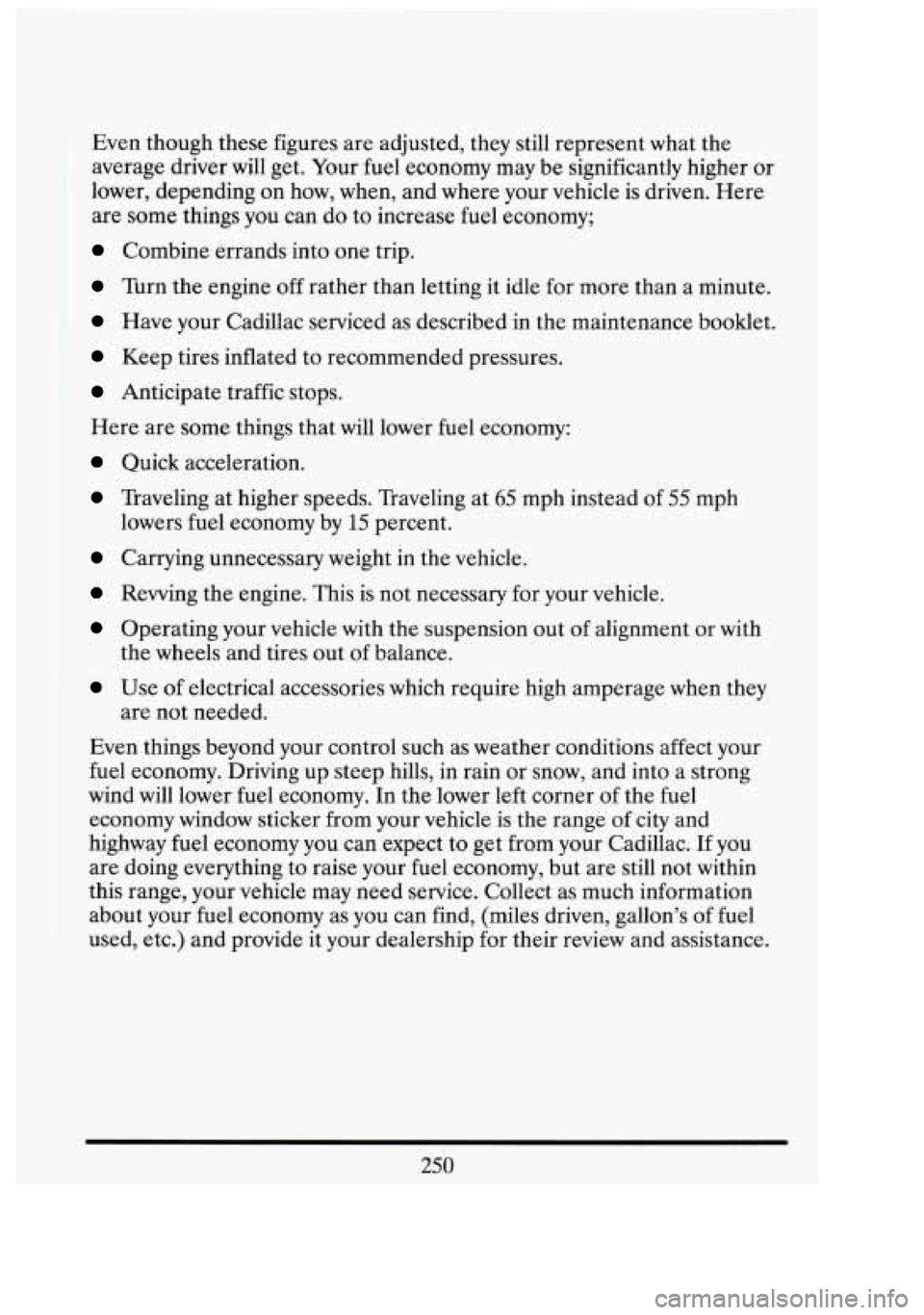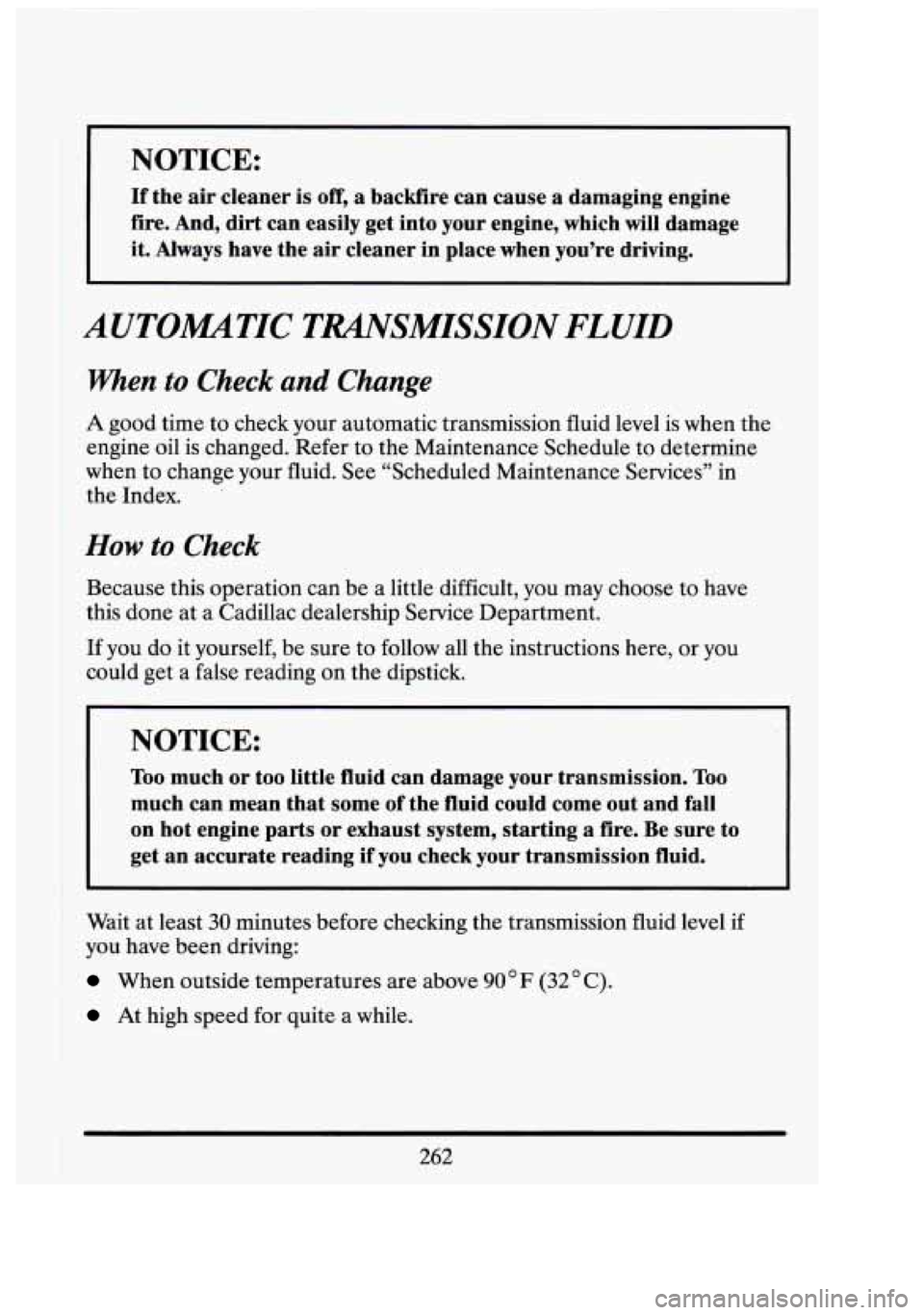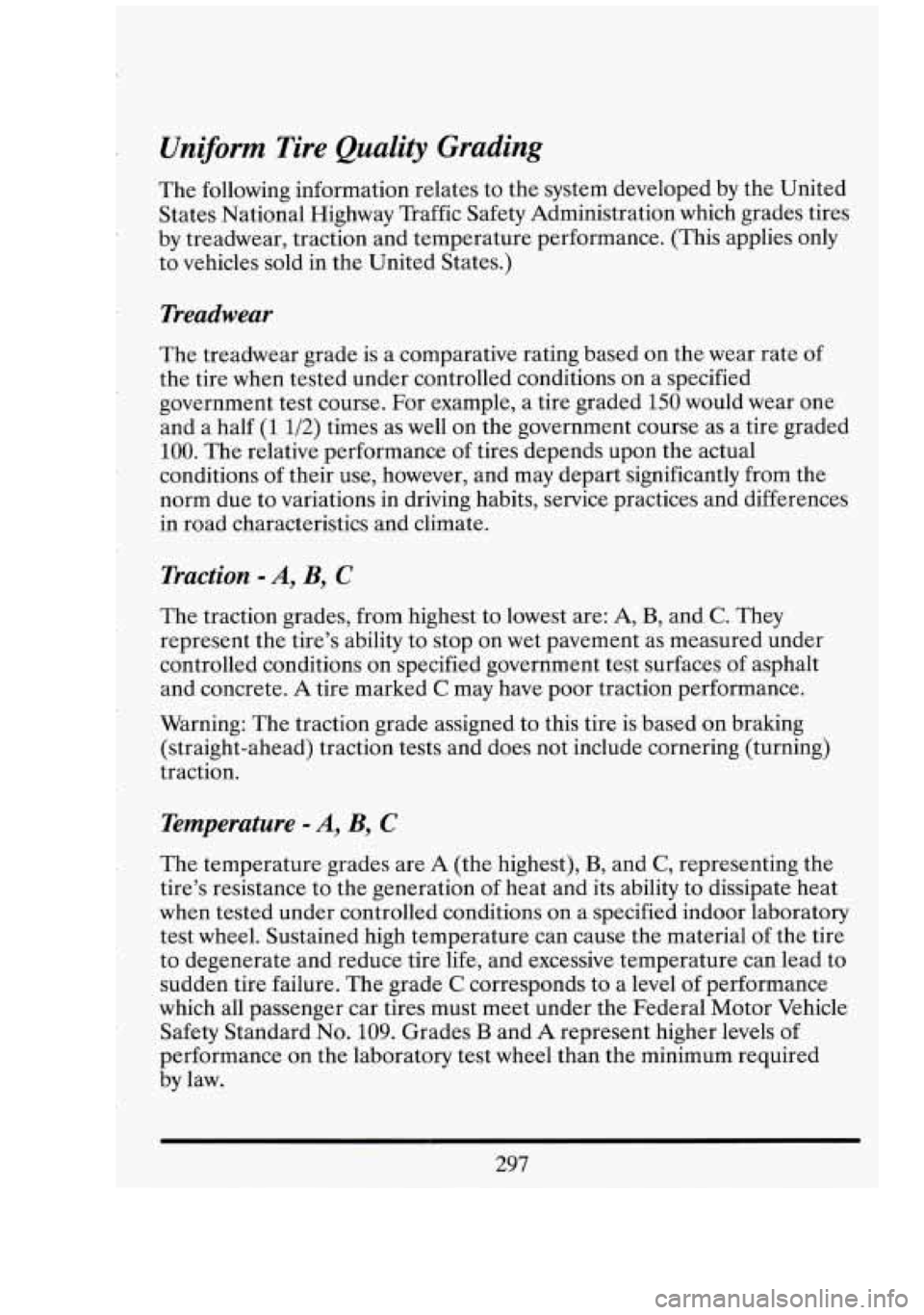Page 261 of 398

I
I
You should ask your service station operators if their gasolines contain
deposit control additives and oxygenates, and if they have been
reformulated to reduce vehicle emissions.
FUELS IN FOREIGN COUNTHES
If you plan on driving in another country outside the U.S. or Canada,
unleaded fuel may be hard to find. Do not use leaded gasoline. If you use
even one tankful, your emission controls won’t work well or at all. With
continuous use, spark plugs can get fouled, the exhaust system can
corrode, and your engine oil can deteriorate quickly. Your vehicle’s
oxygen sensor will be damaged. All
of that means costly repairs that
wouldn’t be covered by your warranty.
To check on fuel availability, ask an auto club, or contact a major oil
company that does business
in the country where you’ll be driving.
You can also write us at the following address for advice. Just tell us
where you’re going and give your Vehicle Identification Number (VIN).
General Motors Overseas Distribution Corporation,
North American Export Sales (NAES)
1908 Colonel Sam Drive
Oshawa, Ontario
LlH 8P7
FUEL ECONOMY
Your fuel economy (miles per gallon or liters per 100 kilometers) can vary
depending on how your Cadillac
is driven. Several vehicles like yours
have been driven through a standard test and their actual fuel economy
was recorded. These readings were adjusted and printed on the fuel
economy window sticker which was attached to your new Cadillac when
it
was delivered and in the Gas Mileage Guide which is available from your
dealership.
The fuel economy estimates are based on results of tests required by the
U. S. Environmental Protection Agency (EPA). These tests are used to
certify that vehicles meet the Federal emissions and fuel economy
standards. Cadillac tests prototypes of new vehicles and submits the
results to the EPA. The EPA then confirms the accuracy of the figures
provided by Cadillac. The vehicles are driven
by a professional driver
under controlled laboratory conditions, on an instrument similar to a
ni
I
I
o(
L
nl
248
Page 263 of 398

Even though these figures are adjusted, they still represent what the
average driver will get. Your
fuel economy may be significantly higher or
lower, depending on how, when, and where your vehicle is driven. Here
are some things you can do to increase fuel economy;
Combine errands into one trip.
Turn the engine off rather than letting it idle for more than a minute.
Have your Cadillac serviced as described in the maintenance booklet.
Keep tires inflated to recommended pressures.
Anticipate traffic stops.
Here are some things that will lower fuel economy:
Quick acceleration.
Traveling at higher speeds. Traveling at 65 mph instead of 55 mph
Carrying unnecessary weight in the vehicle.
lowers fuel economy
by
15 percent.
Rewing the engine. This is not necessary for your vehicle.
Operating your vehicle with the suspension out of alignment or with
the wheels and tires out
of balance.
Use of electrical accessories which require high amperage when they
are not needed.
Even things beyond your control such as weather conditions affect your
fuel economy. Driving up steep hills, in rain or snow, and into a strong
wind will lower fuel economy. In the lower left corner of the fuel
economy window sticker from your vehicle is the range
of city and
highway fuel economy you can expect to get from your Cadillac. If you
are doing everything to raise your fuel economy, but are still not within
this range, your vehicle may need service. Collect as much information
about your fuel economy as you can find, (miles driven, gallon’s of fuel
used, etc.) and provide it your dealership for their review and assistance.
cl;
31
-1
ra
1-1
ra
250
Page 274 of 398
rags containing used engine oil. (See the manufacturer’s warnings about
the use and disposal of oil products.)
Used oil can be a real threat to the environment.
If you change your own
oil, be sure to drain all free-flowing oil from the filter before disposal.
Don’t ever dispose of oil by putting.it
in the trash, pouring it on the
ground, into sewers, or into streams or bodies
of water. Instead, recycle it
by taking it to a place that collects used oil. If you have a problem
properly disposing of your used oil, ask your dealer, a service station or a
local recycling center for help.
AIR CLEANER
c- c
See “Scheduled Maintenance Services” in the Index. Refer
to the
Maintenance Schedule
to determine when to
replace the air filter.
261
Page 275 of 398

-NOTICE:
If the air cleaner is off, a backfire can cause a damaging engine
fire:And, dirt can easily get into your engine, which will damage
it. Always have the air cleaner in place when you’re driving. I
I AUTOAUTIC .TRANsIMISSION FLUID
‘When to Check and Change
A good time to check your automatic transmission fluid level is when the
engine oil is changed. Refer to the Maintenance Schedule to determine
when to change your fluid. See “Scheduled Maintenance Services” in
the Index.
How to Check
Because this operation can be a little difficult, you may choose to have
this done at .a Cadillac dealership Service Department.
If you do it yourself, be sure to follow all the instructions here, or you
cou.ld get a false reading on the dipstick.
I I Too NOTICE: much or too little fluidcan damage your. transmission. Too
much can mean that some of the fluid could come out and fall
on hot engine parts or exhaust system, starting
a fire. Be sure to
get an accurate reading
if you check your transmission fluid. i
I
Wait at least 30 minutes before checking the transmission fluid level if
you
have been driving:
When outside temperatures are above 90°F (32OC).
At high speed for. quite a while.
tll
il
3‘ I
CI)
262
Page 290 of 398
Khicle Storage
If you’re not going to drive your vehicle for 25 days or more, take off the
black, negative
(-) cable from the battery. This will help keep your battery
from running down.
Contact your dealer to learn how to prepare your vehicle for longer
storage periods.
HXOGEN BULBS
EXTERIOR MP HOUSINGS
I NOTICE:
Your Cadillac’s lamp housings are designed with small vents so
moisture will be removed when the lights are on, or after dri\
ving
for a short time.
If an excessive amount of moisture is present
which does not clear, see your Cadillac dealership for service.\
277
Page 307 of 398
3ptional Limousine Packages:
'0 Front and Rear - -35, psi (241 Wa)
Recommended tiresize
is:
'Michelin XW4 P235/70R15 ~.
. 4 Goodyear GA P235/70R15 (Trallermg Option)
0 T145/80D16 (Comnact soare)
Tire Inspection and Rotation
To make your tires last longer, have them inspected and rotated at the
mileages recommended in the Maintenance Schedule. See "Scheduled
Maintenance Services'!
in the Index.
with compact Ispare with fullsize spare
"
4 U
Use .this rotation patte
After-the tires have
b
. . 294
Page 309 of 398
The tire has a puncture, cut, or other damage that can’t be repaired
well because of the size or location of the damage.
Buying New Tires
To find out what kind and size of tires you need, look at the Tire-Loading
Information label.
The tires installed on your vehicle
when it was new had a Tire
Performance Criteria Specification (TPC Spec) number on each tire’s
sidewall. When you get new tires, get ones with that same TPC Spec
number. That way, your vehicle will continue to have tires that are
designed to give proper endurance, handling, speed rating, traction, ride
and other things during normal service on your vehicle. If your tires have
an all-season tread design, the TPC number
will be followed by a “MS”
(for mud and snow).
If you ever replace your tires with those not having a TPC Spec number,
make sure they are the same size, load range, speed rating and
construction type (bias, bias-belted or radial) as your original tires.
ni
-1
Page 310 of 398

Uniform Tire Quality Grading
The following information relates to the system developed by the United
States National Highway Traffic Safety Administration which grades tires
by treadwear, traction and temperature performance. (This applies only
to vehicles sold
in the United States.)
Treadwear
The treadwear grade is a comparative rating based on the wear rate of
the tire when tested under controlled conditions on a specified
government test course. For example, a tire graded 150 would wear one
and
a half (1 1/2) times as well on the government course as a tire graded
100. The relative performance of tires depends upon the actual
conditions of their use, however, and may depart significantly from the
norm due to variations in driving habits, service practices and differences
in road characteristics and climate.
Traction - A, B, C
The traction grades, from highest to lowest are: A, B, and C. They
represent the tire’s ability to stop on wet pavement as measured under
controlled conditions on specified government test surfaces
of asphalt
and concrete. A tire marked
C may have poor traction performance.
Warning: The traction grade assigned to this tire is based
on braking
(straight-ahead) traction tests and does not include cornering (turning)
traction.
Temperature - A, B, C
The temperature grades are A (the highest), B, and C, representing the
tire’s resistance to the generation of heat and its ability to dissipate heat
when tested under controlled conditions on a specified indoor laboratory
test wheel. Sustained high temperature can cause the material of the tire
to degenerate and reduce tire
life, and excessive temperature can lead to
sudden tire failure. The grade
C corresponds to a level of performance
which all passenger car tires must meet under the Federal Motor Vehicle
Safety Standard No. 109. Grades
B and A represent higher levels of
performance on
the laboratory test wheel than the minimum required
by law.
297